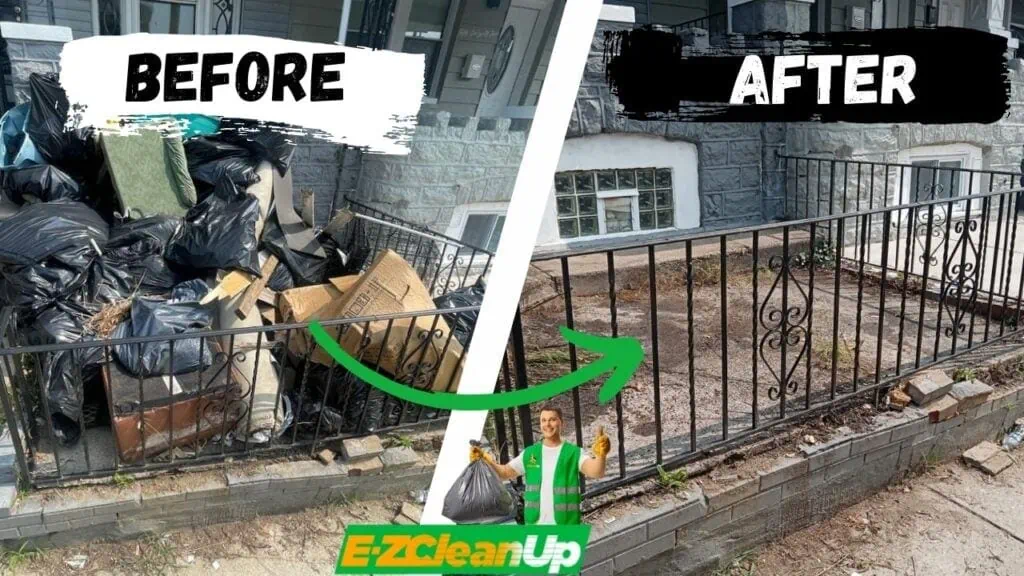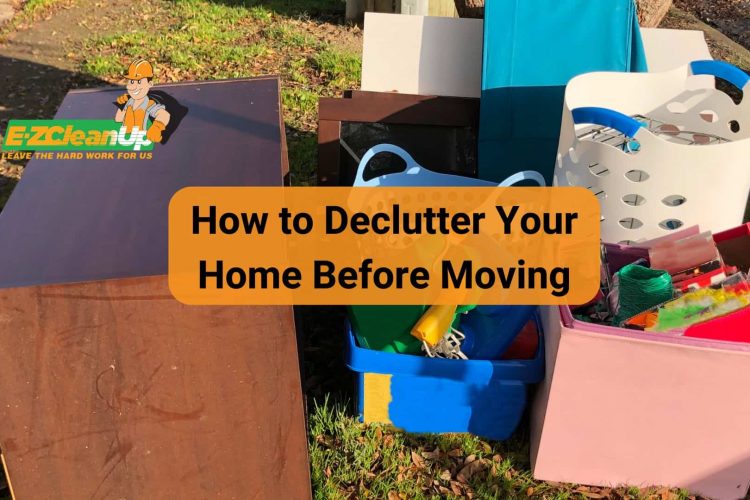Begin decluttering your home by setting a strategic timeline. Focus first on consumables and unnecessary items. This initial step simplifies moving and minimizes waste. It also paves the way for a smoother transition to your new home.
This article will guide you through the steps on how to declutter your home before moving.
Step 1: Planning Your Decluttering Process
Decluttering your home before a big move simplifies the moving process, making it easier to pack, organize, and settle into your new space efficiently. By planning your decluttering process carefully, you can minimize stress, reduce moving costs, and ensure only the items you truly need and love make it to your new home.
Here’s how to tackle the decluttering process effectively.
Setting a Timeline for Decluttering Tasks
Starting early is crucial. Allocate enough time to go through your belongings without feeling rushed. The amount of time needed will depend on the size of your home and the volume of items you have.
By spreading the workload over several days or weeks, you can dedicate a couple of hours each day to decluttering a specific area or category of items. This will make the process less overwhelming and more manageable.
Still searching for a place to move into? SpareRoom offers listings for rooms across major U.S. cities, and their team helps ensure listings stay up-to-date and safe. With helpful customer support, it’s a useful resource for anyone planning a move.
Prioritizing Rooms and Areas to Declutter First
Focus on clearing out extras and consumables first, such as pantry items and personal care products, to reduce the volume of items you need to move. This approach not only simplifies the moving process but also helps you avoid wasting food and other perishables.
Additionally, consider how your needs will change in your new home. Declutter items that won’t fit or won’t be needed in your new space, such as furniture for rooms you won’t have.

Creating a Decluttering Checklist
Using a decluttering checklist can help you stay organized and ensure you don’t overlook any areas or items. Begin by sorting items into categories and deciding what to keep, sell, donate, or discard.
The following tips can also help make the process easier:
- Use the three-box method to sort items: one for keeping, one for giving away, and one for items too worn to keep or donate.
- Consider the weight of items, especially if you’re moving yourself. The heavier the item, the more effort is required to move it.
- Create “holding zones” for items you plan to get rid of, making it easier to organize donations or sales.
When decluttering, it’s essential to be realistic about what you use, need, and love. Ask yourself critical questions about each item’s utility and sentimental value to ensure you’re only moving with items that contribute positively to your life.
And remember, decluttering is not just about making moving easier; it’s also an opportunity for a fresh start in your new home.
Step 2: Follow Effective Decluttering Methods
When preparing to move, decluttering your home is not just about tidying up; it’s a strategic approach to simplifying your life and making your move easier.
Here are some tips for effective decluttering before moving:
- Use Consumables: Try to use up consumable items like pantry goods and personal care products to reduce what needs to be moved.
- Assess Your New Space: Consider the layout and size of your new home to determine what furniture and items will fit and are necessary.
- Don’t Add New Items: Avoid buying new things before the move to minimize the volume of items to pack.
- Declutter by Category: Instead of going room by room, gather similar items together and declutter them as a group. This can provide a better perspective on what you have and what you actually need.
- Consider the Weight: Remember, the heavier the item, the harder and more expensive it will be to move. Decluttering heavy items can save effort and money.
Decluttering before a move is a valuable opportunity to reassess what’s truly important and necessary for your life. By following these tips, you can ensure that you only bring items that serve a purpose or bring joy into your new home.

Step 3: Special Considerations for Different Areas
Decluttering your home before a move can make the transition smoother and help you start fresh in your new space.
Decluttering the Kitchen: Sorting Gadgets and Utensils
The kitchen often houses a variety of gadgets and utensils, some of which you might rarely use. Start by assessing each item with questions like, “Do I really need or use this?” and “Could I borrow this if needed?”
Begin with your countertops to instantly improve the kitchen’s efficiency and appearance. Remove items that don’t belong, declutter small appliances that are collecting dust, and consider space-saving solutions for items you decide to keep.
Moving onto cabinets and drawers, tackle one category at a time. Donate duplicates or items you no longer use. For pantry decluttering, give yourself ample time, remove everything to sort and clean, and consider using bins to organize food categories.
Tackling the Wardrobe: Clothes to Keep, Donate, or Sell
A general rule of thumb for decluttering wardrobes is to divide your clothes into categories: keep, donate, sell, or discard. Ask yourself if you’ve worn the item in the past year and whether it fits your current style and lifestyle. Donating items in good condition can give them a new life elsewhere, while selling higher-value items can offset moving costs.
Managing Children’s Items: Toys, Books, and Clothes
Decluttering children’s items can be a sensitive task. Involve your children in the process by asking them what they still play with and what they’re ready to let go of. Donate or sell items in good condition, and consider storage solutions for keepsakes.
Additional Tips:
- Fridge and Freezer Decluttering: Empty, clean, and organize your fridge and freezer, discarding expired or unwanted food. This helps you start fresh and reduces waste.
- Under the Sink: Don’t forget to declutter the area under your kitchen sink. Empty and categorize items into keep, toss/recycle, donate, and relocate. Clean the space thoroughly before reorganizing.
Step 4: Disposing of Decluttered Items Responsibly
When preparing to move and decluttering your home, disposing of unwanted items in a responsible manner is crucial.
Donating Items to Charity: What to Know
Before donating to a charity, it’s essential to ensure your contributions will be meaningful and effectively used. Start by researching the causes you’re passionate about. Look up potential charities with keywords such as “best charity” or “highly rated charity” plus “complaint” or “scam” to avoid fraudulent organizations.
Check the charity’s website for details on how donations are used, and use reputable organizations like BBB Wise Giving Alliance, Charity Navigator, or CharityWatch to evaluate the charity further. It’s also advised to see if the charity and its fundraisers are registered in your state.

Selling Items: Tips for a Successful Sale
If you decide to sell items instead of donating, presenting them well is key. Make sure items are clean, in good repair, and photographed clearly if selling online. Be realistic about pricing to ensure items sell quickly.
Use platforms that match the nature of your items, like eBay for collectibles or Facebook Marketplace for local sales. Always prioritize safety in transactions. Meet in public places for local sales, or use secure payment methods online.

Recycling and Eco-friendly Disposal Options
When items aren’t fit for donation or sale, recycling or eco-friendly disposal is the next best step. For clothing and household items in less than ideal condition, look into local recycling programs or companies like Planet Aid, which accepts items in any condition for recycling.
Electronics should be recycled through dedicated e-waste recycling programs to prevent harmful chemicals from ending up in landfills. For furniture, mattresses, and larger items, check if your city offers bulky item recycling pickup days or drop-off locations for large recyclables.
Remember, the condition of your donations matters significantly. Charities can only use items that are new, unused, or nearly new. Clothing should be free from holes, stains, and not worn out, as these items may end up costing charities money to dispose of if they can’t be used.
When preparing donations, consider the Golden Rule: donate items in a condition that you would be happy to receive them in. For items that can’t meet the minimum standards for donation, look for specialized recycling options or consider if they can be repurposed creatively.
Finally, donating doesn’t have to be limited to physical items. Consider selling items and donating the proceeds. This offers a dual benefit of decluttering while supporting causes you care about.
Step 5: Preparing for Moving Day
As you prepare for moving day after decluttering your home, it’s essential to approach packing, labeling, and final decluttering steps systematically to ensure a smooth transition.
Packing Tips for a Decluttered Home
Packing a home that has been thoughtfully decluttered can significantly reduce stress and moving costs. Begin by gathering necessary supplies such as vertical wardrobe boxes for easy clothes transfer, color-coded labels for box organization, bubble wrap for fragile items, and sturdy packing tape.
Remember, the key to successful packing is starting early and being consistent. If your move is approaching, dedicate more time each day to packing. For a stress-free experience, you might want to explore professional packing services, which can handle everything from organizing your belongings to ensuring they’re securely packed for transport. Avoid acquiring new items during this period, and focus on decluttering to keep only what you truly need.
Labeling Boxes for Efficiency and Ease
Labeling your boxes can drastically improve the unpacking process in your new home. Utilize color-coded labels to designate boxes for specific rooms and clearly mark the contents on the outside.
This method makes unpacking more manageable. It also ensures that movers place boxes in the correct rooms. Save one label of each color and attach it to the corresponding room’s door at your new home to guide movers accurately.
Final Decluttering Steps Before Moving Day
In the final weeks leading up to your move, focus on decluttering items you haven’t yet sorted through. This includes going through personal and sentimental items, a process that can be emotionally taxing but is necessary.
When dealing with emotional clutter, avoid dwelling on memories that may hinder your progress. Instead, make quick decisions on what to keep and what to let go of. If you find items that evoke strong memories, consider setting them aside to deal with at a later time.
For items you decide not to move with, consider selling, donating, or gifting them. Online platforms and yard sales are excellent ways to sell items. For items that cannot be sold, donated, or gifted, recycling or proper disposal is the next best option.

Ease Your Move: Decluttering Simplified
Handling the clutter before relocating often leads to the challenging task of disposal. EZ CleanUp offers a straightforward solution. We offer services, including junk removal, dumpster rental, and more, to streamline your moving process.
Call us and let our team of experts manage the clutter and make your move worry-free.













